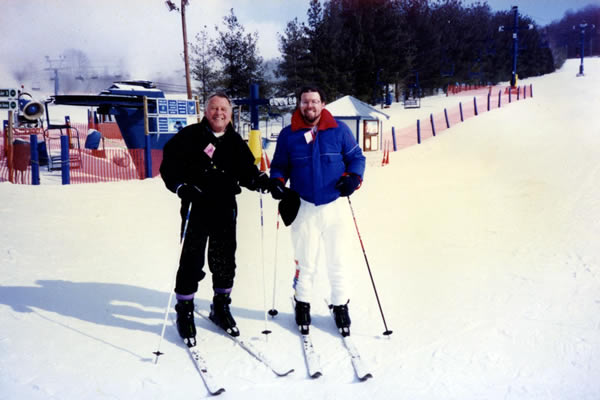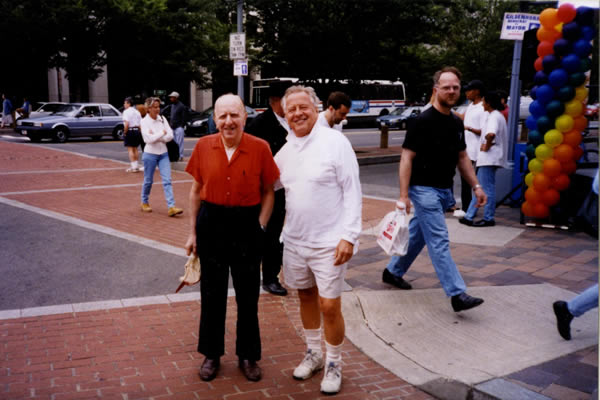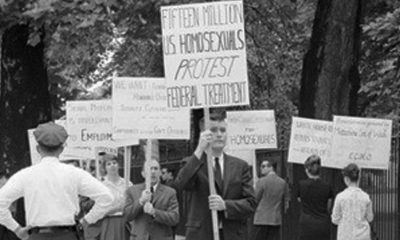Living
Labor of love
Md. man remembers late spouse, years of activism
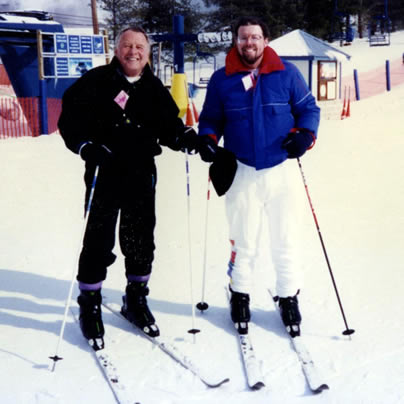
GLEN BURNIE, Md.—Larry Esser was 25 when he met Tom Toth on his first day of work at the old Chessie System’s office in Baltimore in June 1981. The Centers for Disease Control and Prevention had just reported the first cases of what later became known as AIDS. Maryland’s anti-sodomy law was still on the books, but Toth, who was 32 years older than Esser, felt it was important to live his life as an openly gay man.
“Tom kind of pursued me, to put it quite bluntly,” Esser tells the Washington Blade during a Dec. 13 interview. “I really liked him, that’s the funny thing. I didn’t feel like he was imposing himself or anything like that … he’s the bravest person I’ve ever met. His personal courage astonished me.”
Esser stressed he “had no idea I was gay” when he met his future spouse. He grew up in what he describes as an “extremely strict Roman Catholic household” in Connecticut where he routinely heard gay people “were probably worse than murderers and they were to be avoided at all costs” and they were “mentally defective.” Esser eventually found himself in a relationship with another man he conceded wasn’t “going anywhere” when Toth finally made his move.
“He was sitting at his desk and he was singing,” Esser recalls, laughing. “It was like in a joking sort of way he was singing and the other people around him were laughing when he was doing it and he was singing something about it’s springtime and it’s time for love. The way he tells this story, I came in the door and heard him singing that and I tried to sneak away. I didn’t want any part of that. And he saw me and he said, ‘Uh oh.’ And that’s when he began to realize that I was not what he thought I was. How can you explain how two people fall in love? I can’t explain that. But it just happened. I wasn’t afraid of him personally.”
Couple’s activism starts at home
The couple routinely engaged in what Esser calls “guerrilla activism” that began when he said the railroad fired him after they began dating in 1983 because of his sexual orientation. He considered moving back to Connecticut, but Toth insisted he move into the small Glen Burnie home he shared with his then-84-year-old mother, Mary.
“There was no arguing with that,” Esser says. “The funny thing is when he said it, it was exactly what I wanted to hear, but of course I couldn’t ask him that. It was up to him to ask me, and he did. And I was delighted.”
Esser took care of Toth’s elderly mother until she died the following year. He says the same Chessy System vice president whom he claims fired him threatened to do the same to his partner once he found out they were living together. (He says the railroad in the late 1970s had tried to fire an early member of the Baltimore Gay Alliance that later became the GLBT Community Center of Baltimore and Central Maryland, but the union fought for him.)
“He couldn’t do it directly,” Esser says, recalling efforts to fire Toth, who was a unionized stenographer. “He did a bunch of different things to try to get Tom to quit. And amazingly, Tom was actually ready to resign. A woman whose name I can’t remember, but will always be grateful to her told him don’t resign because the railroad is going to do a bunch of buyouts and you’ll be able to get a lump sum payment and retire, and that’s what he did.”
The couple also for years distributed copies of the Blade at locations throughout Anne Arundel County.
They decided to approach the Anne Arundel County Public Library Board of Trustees in Annapolis in 1993 after they read about the newspaper’s threatened lawsuit against the Fairfax County (Va.) Library for its proposed ban on the publication’s distribution inside its branches. Esser said Toth was “really rough with them,” in part because “he’d gone through a very repressive time back in the 1950s.” (He lived in Manhattan for 25 years and the New York Police Department once arrested him during a gay bar raid.)
“When we got to the library board, he told them point blank, ‘You’d better do this,’” Esser says. “They were not happy. They were not happy at all. I think some of them were actually kind of sympathetic to what we wanted to do, but they were taken aback by how assertive he was. They weren’t used to that. The library board is used to people coming and requesting things, not telling them what they’re going to do. And they were not happy.”
Esser says one of the board members later told him the board did not want to meet with Toth anymore because “he was very blunt,” but in the end they granted them permission to place 15 copies of the Blade in libraries in Glen Burnie, Severna Park and Annapolis. They continued distributing the Blades each week from the Center for more than two decades.
“By putting the paper there, I always felt that, I always wondered … if a young person going by thinking they were maybe gay or knew they were gay but felt very isolated, if they saw those papers, maybe that would give them a little bit of encouragement or a little bit of reassurance. But the other point was just sheer visibility. By having those papers there, Tom used to say … if even one person picks one up, he said even if they throw them away they still got to look at them. And that was an excellent point. And he was quite right. That meant a lot to us.”
Trust the truth
The AIDS epidemic had begun to exert its toll on gay men by the time the couple began dating — Esser recalls a time both he and Toth went to a small Severna Park health clinic to get HIV tests. Toth says the nurse asked him whether he was a gay man. “He said that was the first time in his entire life anyone asked him that directly,” Esser says. “He had never been asked that question.”
Esser says he felt the atmosphere during the late 1980s was “pretty optimistic” in spite of the epidemic and late-North Carolina Sen. Jesse Helms, fundamentalist preachers Jerry Falwell and Pat Robertson and other social conservatives who sought to demonize gay men during the AIDS crisis.
“Oddly enough, Tom never disliked [then-President Ronald] Reagan, but I think that’s because he remembered him from his movie star days,” Esser says. “He felt Reagan didn’t understand the whole situation that he was dealing with AIDS and gay people. He felt that Reagan really just didn’t understand it. It’s not that he was anti-gay particularly; he just didn’t really know what he was doing … I didn’t feel so kindly to Reagan at all. I thought he was just horrible.”
Toth and Esser also became involved in the effort to add sexual orientation to Maryland’s non-discrimination law in the 1990s.
He recalls one legislator who was “really being ridiculous, saying really ugly things about us” during a hearing on the measure in Annapolis. One of this lawmaker’s colleagues who had refused to listen to his speech asked Toth and Esser how they could stand to hear his rhetoric.
“Tom said, ‘Well we know it isn’t true, so we don’t worry about it,’” Esser says. “Of course you’ve got to fight. You can’t let people say things that aren’t true and let them say it without challenging it. And Tom did that. But at the same time you can’t let it stop you. You can’t let that negativism stop you. You have to keep fighting, pushing against it and that’s what Tom really, really did.”
Esser notes that Toth’s life spanned the same period through which Frank Kameny lived — the two met during the 2000 D.C. Pride parade. And Esser says when they met, it was as if they were kindred spirits.
“They were really speaking the same language,” he says, noting both Esser and Kameny came of age in the 1950s when lobotomies were performed as a way to cure homosexuality. “It was very impressive for me being a younger person relative to them seeing what these two men must have come through and how they were both so determined to do what they were doing. They refused to back down. They refused to accept what they were being told they had to accept. They wouldn’t do it. And that was a beautiful thing to me. It’s a moment I will never forget.”
Mesothelioma that Toth developed from asbestos exposure while working at a Baltimore shipyard that built liberty ships during World War II had already taken its toll by the time Gov. Martin O’Malley signed the state’s same-sex marriage law in March.
Toth and Esser legally married in D.C. in 2010, but he wanted to vote for both Question 6 and President Obama on Election Day. He applied for an absentee ballot because he did not think he would live until Nov. 6.
It arrived in the mail in early October.
“It came and I said do you want to sign it?,” Esser, who fought leukemia at the same time his spouse struggled with mesothelioma, says. “And he said, ‘No, I’ll do it tomorrow. Well the next day he wasn’t strong enough.”
Toth died three days later — on Oct. 11 — at age 88.
“He never did sign the absentee ballot,” Esser says. “He was very aware of what was going on. He was politically interested. He definitely wanted Obama to win. We just detested Romney. The hardest thing to communicate to people who were not gay (is) how much Obama had done to us, compared to everybody else.”
Esser says Toth wondered whether history would remember Obama along the same lines as Franklin Roosevelt in terms of “what he had done, particularly for gay rights.”
“When you come from a time where you were ignored totally … and suddenly here’s the president and he’s doing all these executive orders and this happening and that’s happening and then he comes out in favor of same-sex marriage, well that’s fantastic,” Esser says. “He was just delighted.”
Related content:
Great places to get married in Maryland
Before you wed — legal considerations
Advice
How to cope when a partner gives you the silent treatment
Punishing behavior brings up memories of parent’s mistreatment
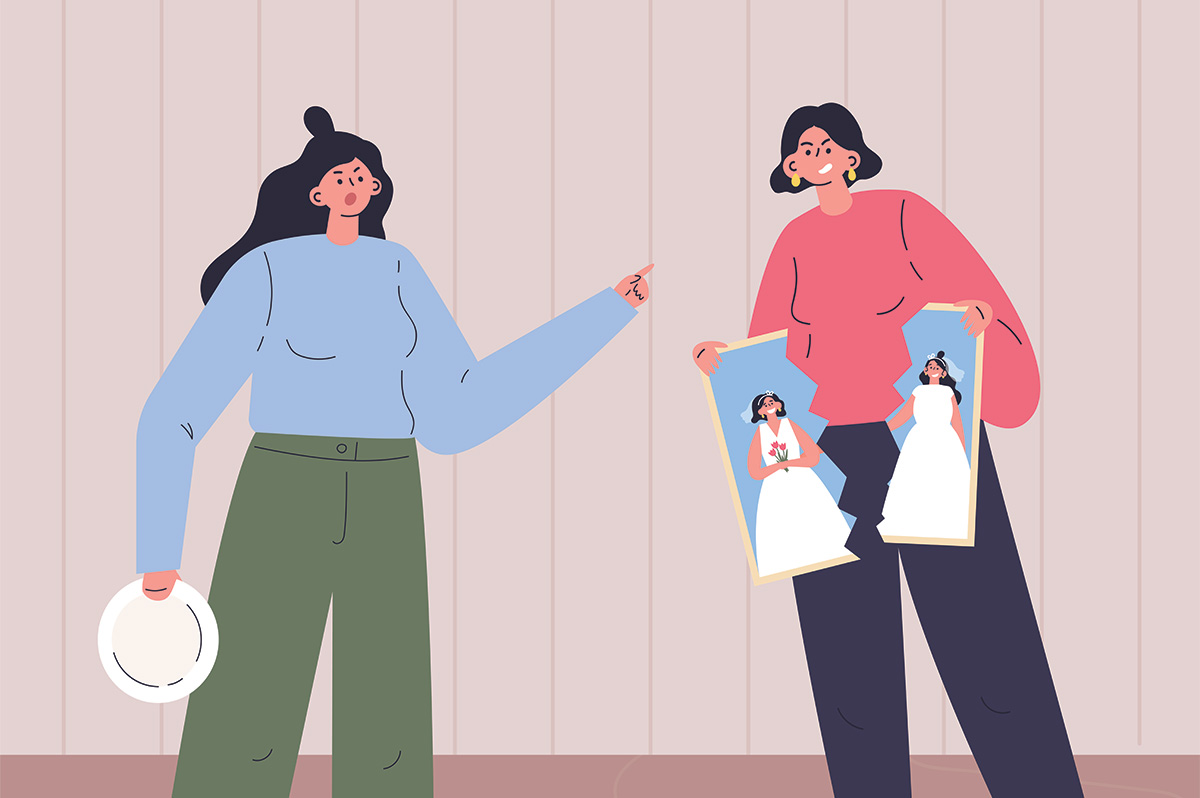
Michael,
My wife and I met less than two years ago and we were crazy about each other from the start. We wanted to spend life together so we just went for it. Maybe this wasn’t the most well-thought out decision on either of our parts but we thought that love conquers all.
But lately we’ve been arguing. The stuff we’re fighting about is never such a big deal: chores, or spending, or wanting to do different things on the weekend. But when I don’t want to go along with Michelle’s point of view, she gets angry and shuts down. Sometimes she stops talking to me for as long as a few days.
This is painful for me. My mom used to pull this stunt when I was a kid and she was mad at me. She also cut me off when I came out. We’re still estranged.
Michelle has a whole different take on this. She says I am being “mean” to her (when I don’t go along with what she wants) and this is painful, and she has to “take a break” to cool off.
I know she comes from a volatile family. She has told me there was a lot of screaming in her house, and she barely has a relationship with her parents as a result. So I get that she’s sensitive to conflict.
But I don’t think I’m being mean to her by standing up for what I want — certainly not enough to warrant her giving me the silent treatment.
We got married to have a great life together. We often do but I can’t live with someone who just shuts me out when she’s annoyed with me.
If I became a doormat and went along with everything she wants and never pushed back or complained, maybe she wouldn’t shut down. But I don’t want to do that.
I’d appreciate some ideas to improve the situation. I don’t want a divorce but I also don’t want to keep being mistreated.
Michael replies:
You can think of marriage — or any serious relationship — as a gym where you have ongoing opportunities to become an increasingly resilient person in the face of the ongoing challenges that an intimate relationship poses.
Your task here is to shift your focus toward figuring out how to handle yourself well, even in the awful circumstance of getting the silent treatment.
Michelle is not under an obligation to behave as you’d like her to. You can certainly ask her to stop withdrawing when she’s angry at you. But that doesn’t mean she is going to honor your request.
I well understand that Michelle’s punishing behavior is bringing up painful memories of your mother’s mistreatment. But if she doesn’t change her behavior, you have to find a way to live with Michelle as she is, with as much equanimity as you can muster, for as long as you choose to be married to her. If she does not change and you find her behavior to be unbearable, you can leave.
Every time she shuts down, Michelle is handing you an opportunity to figure out how you, yourself, can deal with feeling hurt and let down, rather than depending on someone else to behave as you’d like her to, or not upset you, or soothe you. Being in charge of your own mood rather than letting someone else press your buttons is a great skill to get better at.
I’m not going focus on what techniques you might use to soothe yourself — that’s a different column (or even better, a number of therapy sessions). That said, knowing that Michelle’s behavior comes from her history might help you to take it less personally. And, simply keeping in mind that living with a difficult spouse is unavoidable and worth getting better at may help you to quiet yourself down.
Another challenge that your marriage is pushing you to work on: Discerning when you can be generous, and when it is important to have a boundary. Of course, I understand that you don’t want to be a doormat by going along with whatever Michelle says and wants. But is it possible that she has a point, in that you could stand to lean more in her direction?
None of us get to have everything the way we want when we are in a relationship (much less in life). Figuring out the interplay between generosity and boundary is complicated. It often involves considering what is important to your partner; and deriving joy from her getting some of what is important to her, not only from your getting what you would like. And of course, it also involves figuring out what is most important to you.
If you set a boundary thoughtfully, because something is important to you, and Michelle doesn’t like it, you’re being handed an opportunity to get better at tolerating disappointment. Being a disappointment to your partner, and being disappointed in your partner, are both unavoidable parts of marriage: We’re all different, and at times will make choices that the other person really does not like.
If we make our decisions from a place of integrity rather than whim, entitlement, anger, or “whose turn it is”, and strive to honor the choices that our partners make from a place of integrity, this often makes the disappointment easier to bear.
Of course, it would be great if Michelle would join you in working to become a more solid and resilient spouse. As I mentioned earlier, you can’t persuade her to do so. But you can certainly tell Michelle what you are working on and ask her to consider how she, too, might use your relationship difficulties as a challenge to grow.
It isn’t easy to have such a conversation without sounding condescending. You are better positioned to do so when you are walking the walk, not just talking the talk. One good rule of thumb is to put you and your partner in the same boat, making it clear that you see the two of you as facing the same challenges, rather than positioning yourself in a superior position. Another is to initiate the conversation when you are both calm, rather than in the middle of a fight or when you’re getting the silent treatment.
One more point: If Michelle is willing, I’d suggest that you propose couples therapy as an opportunity for you two to collaborate on building a consistently loving relationship where neither of you lets your reactivity run the show.
Michael Radkowsky, Psy.D. is a licensed psychologist who works with couples and individuals in D.C. He can be found online at michaelradkowsky.com. All identifying information has been changed for reasons of confidentiality. Have a question? Send it to [email protected].

Electric-vehicle tax credits may have faded earlier this year, but EVs themselves are far from losing their spark. There are more charging stations than ever, battery ranges are longer and more realistic, and automakers have finally figured out that EVs don’t all need to look like geeky science projects or feel like failed beta tests.
Just look at these two compact electrics, which are futuristic, fun and flexible enough for work or play.
HYUNDAI IONIQ 5
$37,000 to $48,000
Range: 245 to 318 miles
0 to 60 mph: 4.5 to 7.4 seconds
Cargo space: 26.3 cu. ft.
PROS: Fast charging. Roomy cabin. Silky-smooth suspension.
CONS: Wide turning radius. Rear wiper not on all trims. Price creep.
After being introduced three years ago, what’s new for the latest Hyundai Ioniq 5? Mostly refinement. Charging is quicker, software is smarter and Hyundai continues to quietly listen to feedback, tweaking ride comfort and usability. Think of it as switching from messy eyeliner to a perfectly sharp wing.
Exterior styling remains one of this EV’s biggest conversation starters. Those pixel-inspired lights, crisp lines and slick hatchback-meets-crossover proportions exude refreshing confidence. There’s no trying to blend in, and that’s the point. Park this Hyundai anywhere and heads will turn.
On the road, the Ioniq 5 prioritizes calm over chaos. Steering is light, the suspension smooths out rough pavement and acceleration feels brisk without being aggressive. Safety tech is plentiful and well-calibrated—adaptive cruise control, lane-centering, blind-spot monitoring—all working together without seeming like a nervous backseat driver. IOW, this ride is supportive, not clingy.
Inside, the user-friendly cabin shines. The flat floor and long wheelbase create a lounge-like atmosphere, with excellent legroom and airy visibility. Seats are well-bolstered and available with eco-friendly materials, and the sliding center console adds flexibility. Cargo space is generous, and the wide windshield makes city driving stress-free. Alas, the rear wiper is only available on select models. Overall, though, I appreciated how everything looks modern without feeling cold.
What makes this Hyundai special is its vibe. An EV that embraces individuality without shouting about it.
Fun fact: The Ioniq’s ultra-fast charging can add hundreds of miles in under 20 minutes—perfect for those who hate waiting almost as much as they hate small talk on awkward first dates.
VOLKSWAGEN ID.4
$46,000 to $59,130
Range: 206 to 291 miles
0 to 60 mph: 4.4 to 7.7 seconds
Cargo space: 30.3 cu. ft.
PROS: Sure handling. Decent range. Good storage.
CONS: Body roll in curves. Fussy infotainment. No frunk.
The latest VW ID.4 focuses on polish. Software updates have fixed earlier frustrations, and overall drivability feels more cohesive. Less “learning curve” and more “hop in and go,” like a dependable bestie who doesn’t overthink things.
Styling-wise, this EV is intentionally inoffensive. Soft curves, friendly lighting and a familiar crossover shape make it approachable. While the ID.4 won’t turn heads like the Ioniq 5, that’s OK. It’s more akin to a classic outfit that always works—timeless, not trendy.
Driving the ID.4 is relaxed and predictable. This SUV prioritizes comfort over thrills, with a suspension tuned for daily commuting and long highway drives. Safety features are comprehensive and reassuring, including excellent lane assistance and collision-prevention systems. It’s the kind of car that quietly has your back, no drama required.
Inside, the ID.4 offers a calm, uncluttered cabin with good space for passengers and cargo alike. Rear-seat legroom is especially strong, making it a solid road-trip companion. The seats are plush, visibility is good and while the infotainment system isn’t the most intuitive, it’s improved enough to be more than tolerable.
The ID.4’s special sauce is balance. It doesn’t try to reinvent the wheel—it just electrifies it.
Fun fact: This is one of the most globally popular EVs, proving that sometimes being universally liked is a strength, not a personality flaw. Think, gold star gay who still surprises you.

Real Estate
Child- and pet-proofing your home for the holidays
It isn’t about being perfect but about being prepared

The holidays are meant to be joyful, cozy, and full of laughter — but if you have young children or pets, they can also feel a little chaotic. Twinkling lights, shiny decorations, guests coming and going, and tables full of tempting food can turn your home into a wonderland of curiosity and mischief. The good news? With a little thoughtful planning, you can keep the holiday magic alive while making your home safer for everyone who lives there.
There’s something oddly comforting about movies where animals go to war with holiday decorations, turning carefully strung lights and perfectly placed ornaments into chaos. Whether it’s a mischievous dog tangled in tinsel or a curious cat launching a full-scale assault on a Christmas tree, these scenes tap into a universal experience for pet owners.
The humor comes from the contrast: the human characters are trying to create warmth, tradition, and picture-perfect cheer, while the animals see the decorations as toys, obstacles, or personal enemies. The resulting destruction — trees tipping over, ornaments shattering, lights blinking out—feels exaggerated but relatable, especially during the already hectic holiday season.
Let’s start with decorations because they tend to be the biggest attraction. Ornaments sparkle, garlands dangle, and everything seems designed to be touched, pulled, or tasted. If you have little ones or pets, consider placing your most fragile ornaments higher on the tree and using shatterproof options on the lower branches. Tinsel and ribbon may look festive, but they can be dangerous if swallowed, so skipping them or keeping them well out of reach is a simple way to reduce risk without sacrificing style.
Holiday lights are another favorite fascination. Before hanging them, take a few minutes to inspect each strand for frayed wires or broken bulbs. Secure cords along walls or behind furniture so they’re harder to grab or chew and unplug them when you leave the house or head to bed. Not only does this help prevent accidents, but it also gives you one less thing to worry about during a busy season.
The Christmas tree itself can become a focal point for exploration. Make sure it’s sturdy and well-anchored so it doesn’t tip if a toddler tugs on a branch or a pet decides to investigate. If you use a real tree, cover the water base since tree water can contain additives that aren’t safe if consumed. For artificial trees, keep an eye out for loose pieces or needles that could become choking hazards.
Food is a big part of holiday celebrations, and it’s also one of the most common sources of trouble. Many traditional treats—like chocolate, grapes, raisins, alcohol, and foods containing xylitol—are dangerous for pets. Keep plates and serving dishes up high, secure the trash can, and gently remind guests not to slip pets or kids “just a little bite” without checking first. For children, be mindful of hard candies, nuts, and small treats that could pose choking risks.
Candles and fireplaces add warmth and charm, but they deserve extra caution. Flameless candles are a wonderful alternative if you want ambiance without worry. If you do use real candles, place them well out of reach and never leave them unattended. Fireplaces should always have a sturdy screen or gate, especially with crawling babies or curious pets nearby.
Holiday gatherings bring wonderful energy into your home, but they can also create new challenges. Doors opening frequently make it easier for pets to slip outside, so consider setting up a quiet, comfortable space where they can relax during busy get-togethers. This can help reduce stress for them and give you peace of mind. For children, stair gates, locked cabinets, and clear boundaries can help prevent accidents when there’s extra excitement in the air.
New toys and gifts are another thing to watch closely. Packaging, twist ties, plastic wrap, and especially button batteries should be cleaned up promptly. These items are easy to overlook in the excitement of gift-opening but can be dangerous if swallowed. Taking a few minutes to tidy up as you go can make a big difference.
Lastly, try to keep routines as steady as possible. The holidays naturally disrupt schedules, but familiar mealtimes, naps, walks, and bedtime rituals help children and pets feel secure. A calmer household often means fewer accidents and a happier experience for everyone.
At the end of the day, child- and pet-proofing your home for the holidays isn’t about being perfect but about being prepared. A few small adjustments can help you relax, enjoy your guests, and focus on what truly matters: creating warm, happy memories with the ones you love. When your home feels safe, the holidays feel even sweeter.
Valerie M. Blake is a licensed Associate Broker in D.C., Maryland, and Virginia with RLAH @properties. Call or text her at 202-246-8602, email her at [email protected] or follow her on Facebook at TheRealst8ofAffairs.

